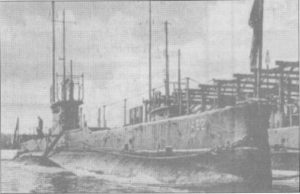- Author
- Spencer, Mark
- Subjects
- History - WW1
- Tags
-
- RAN Ships
- HMAS AE2
- Publication
- September 1999 edition of the Naval Historical Review (all rights reserved)
The diary of a Woy Woy man has become a vital piece of the puzzle for historians putting together the history of the Australian submarine AE2, which sank near Gallipoli in 1915.

After enduring more than three years as a prisoner of war building portions of the Berlin to Baghdad railway, Able Seaman John Harrison Wheat, of Woy Woy, penned a short volume of memoirs which is now housed at the Australian War Memorial.
The only record of his address on his return to Australia is his signing of the memoirs “J Wheat, Woy Woy”.
Following the location of the AE2 in 1998 after an extensive search and its positive identification last year by an Australian team led by Turkish archaeologist Selçuk Kolay, the NSW Heritage office now wants to locate any of Mr Wheat’s relatives to help complete the history.
A substantial collection of original documents, plans and photographs including Mr Wheat’s diary, also has been assembled in preparation for a possible return trip to Turkey and the vessel’s final resting place.
In his detailed personal memoir of the AE2‘s demise and the capture of her crew, Mr Wheat said problems with a main ballast tank forced the ship to resurface despite a rapidly approaching torpedo boat and a gunboat coming from Gallipoli.
Two shots into the engine room made it impossible to dive again and the submarine remained under fire as her crew came on deck to surrender.
“We had no means of putting up a fight as we had no gun and we could not fire our remaining torpedo,” he wrote.
“During the time we were laying on the surface before we surrendered, the torpedo boat fired two torpedoes at us and the gunboat one.
“If we had been struck by one of these torpedoes we should have been blown out of the water.
“When we came on deck to surrender the gunboat and torpedo boat were still firing on us, but immediately we surrendered the torpedo boat stopped firing and commenced steaming around at full speed blowing her siren to try and make the gunboat stop firing.
“The submarine was lying at an angle down by the bows and sinking very slowly, everybody had plenty of time to get on deck.
“The torpedo boat ran up close to us and threw out lifebuoys and lowered a small dinghy.
“Our coxswain called out and told all those who could swim to jump in and go towards the torpedo boat, and those who could not swim so well were to get in the dinghy.
“Just as everybody was clear, submarine AE2 sank beneath the surface at 12.15pm on April 30, 1915.” In a preface to the memoir, Wheat spoke of how he missed the AE2 after 18 months on board and of how he began to keep a diary but stopped after the backbreaking work of laying the railway through the Taurus Mountains began.
He spent three years in the mountainous country, during which he made two escape attempts, both unsuccessful.
Suffering fevers, he neglected the diary task.
“The harsh conditions imposed on us by our German taskmasters, the many spells of sickness in the hospitals and the time taken in my two attempts to escape took up quite a large part of my time there, and formed surroundings which were not conducive to a written record of things one wished to forget,” he wrote.
“However, with the help of two notebooks which I was fortunate enough to keep with me undiscovered, and in which I jotted down the important events of my sojourn there, I can truthfully say that aided by memory’s diary, where the writing is not blurred but very distinct, I am able to fill in the gaps and give a connected and accurate account.
“My hope is that this brief record may be as interesting to the readers as it is unforgettable by me.”
Anyone who knows of Mr Wheat’s family or any of his descendants should phone Tim Smith at the NSW Heritage office on 9849 9575.




